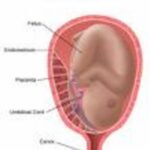Fetus in fetu is a very rare occurrence, affecting one in perhaps every 500,000 births, in which an unformed fetus is discovered in the body, usually the abdomen, of a twin. There usually is the semblance of vertebrae and buds of limbs. However organs, when present, are malformed and mostly dysfunctional, containing no brain. Although the unformed mass receives a blood supply from the twin, there is no hope of its survival outside the host twin.
It is thought the fetus in fetu originates with a monozygotic twin pregnancy. Both fetuses share one placenta and one fetus envelops the other, the enveloped fetus then becoming a parasite and unable to continue with normal formation.
There have been fewer than one hundred fully documented cases of fetus in fetu. This may stem from the fact that the fetus in fetu can be mistaken for a more common growth known as a teratoma. A teratoma consists of various kinds of tissue which don’t normally grow together at the specific site. The site of teratomas is normally also in the abdomen, in testes or ovaries.
Most documented cases of fetus in fetu are discovered when the host twin is in infancy. The survival rate of the host twin is high upon removal of the parasitic twin. Fetus in fetu is diagnosed through ultrasound and computer tomography scan, as well as x-ray and tissue analysis after growth removal.
The anomaly fetus in fetu has been reported sporadically in the media, some publicized cases including:
In 1999, a man from Nagpur, India named Sanju Bhagat, after complaining of a swollen belly and severe pain, was found to have held his parasitic twin in his body for 36 years. The growth was successfully removed. It was a difficult surgery since the twin had grown into many parts of Bhagat’s abdomen.
Surgeons in Pakistan removed two fetuses in fetu from the abdomen of a two-month old baby girl in 2006.
After a nine year old girl in Athens presented with a diagnosed tumor on the right side of her belly, a two inch fetus was removed with head, eyes and hair.
Seven year old Kazakhstan school child Alamjan Nematilaev was referred to a hospital by his school doctor in 2003, upon discovery of movement in his extended abdomen. A cyst was suspected, but when the operation to remove it was performed, a partially formed fetus was removed. The parasitic twin was fairly well-developed, with a head, a rudimentary face, hair, legs, fingers with nails, and genitals.
In 2009, a very rare case of fetus in fetu was discovered, when the body parts of a fetus were found in a Colorado girl’s brain in 2008. These parts consisted of a foot, thigh, and another partially formed foot and hand.
It is important to remember that the fetus in fetu occurs extremely rarely. Many times the only condition separating the diagnosis from a teratoma is the presence of a spinal column. Thus, if an individual is pregnant or studying an extended abdomen in the mirror, fetus in fetu is the last thing to be considered.
Sources:
Mayo Clinic
National Institute of Health
Discovery Health
Journal of Medical Case Reports


